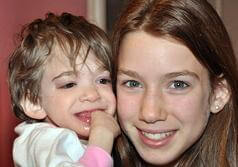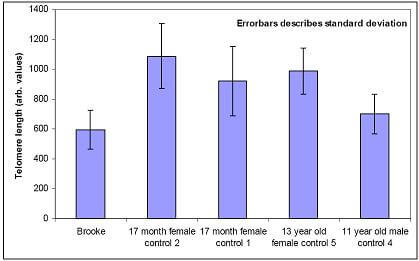What Secrets Are in the DNA of 17 Year Old Girl With Body of a Baby?

Share
Brooke Greenberg was born in January of 1993. She's now more than seventeen years old, but she physically looks to be about one. Doctors have long been baffled by her condition, sometimes referred to as Syndrome X, because no one knows what it is. She seems to be the only living person in the world with her peculiar defiance of aging. Richard Walker from the University of South Florida, believe that mutations in her DNA may be the force behind her apparent eternal youth. According to the Times Online, he and other experts recently discussed Brooke's case at the Royal Society in London. Solving the mystery of Brooke Greenberg could reveal some valuable insights into how our bodies age and grow. There's a Dateline video from a few years ago explaining her condition after the break. My heart goes to her and her family who have been dealing with these difficult circumstances for so long.
Recent research into the lifespan of animals has shown that the alteration of a few genes can lead to large increases in life expectancy. For humans, studies of centenarians have revealed key gene sequences, or sometimes even single gene variations, which are excellent predictors of who will live into extremely advanced age. It is possible then, that Brooke's condition may be the result of just a few mutations in key genes in her DNA. If so, we should be able to sequence her genome, compare it to various control groups, and find some or all of the variations that produce her extended youth. Sadly, it is unlikely that these insights would be able to 'cure' Brooke because of the complexity of her syndrome. But that information could still be put to good use. We may be able to eventually design treatments that try to reproduce some of the effects of Brooke's condition in others for their benefit.
This video was shot in 2006, when Brooke was around 13 years old.
https://www.msnbc.msn.com/id/32545640
It's unclear, however, just how much of Brooke's condition you would even want to replicate, because we do not have a clear understanding of the exact effect her DNA has on her body. We say Brooke has the body of a one year old, and as far as shape is concerned, that's about right. Still, her body does show some signs of being older. As discussed in Walker's case study of Greenberg in 2006, her bones relative age is different than their chronological one. Not only are the bones smaller, but they appeared consistent with the tissue of a ten year old (when Brooke was 13). Even now, she still has her baby teeth, but at age fourteen these teeth matched the standard profile for an eight year old. Clearly her bone cells are aging to some degree, but not in a predictable way.
Be Part of the Future
Sign up to receive top stories about groundbreaking technologies and visionary thinkers from SingularityHub.


Looking more in depth at her cells reveals even more disparities. Telomeres are the tips of our chromosomes that shorten with each replication of our DNA. Scientists have linked telomere decay to the aging of our cells. In fact, the latest Nobel Prize in Medicine was awarded for research into the telomere phenomenon. Walker ran an analysis of Brooke's chromosomes to determine her telomere length. Brooke's were slightly shorter than control subjects for both her physical and chronological age. But these results aren't drastic enough to be particularly enlightening. Walker also used FISH to rule out microdeletions in her genes as a possible mechanism for her condition. Looking for easy answers in the structures of her DNA just hasn't panned out. Scientists need to look inside.
Which, more than likely, is what will eventually happen. Whole genome sequencing is becoming cheaper, and biobanks are building up large stores of DNA from people with detailed medical records. The elements needed to explore Brooke's genome exist. If the answers lie there (there's no real guarantee they do, of course), we could probably find them. There's no clear indication, however, what future studies may be performed on Brooke's behalf. Clearly the Royal Society meeting (this one, I think) is a good sign that research will continue, but I was unable to confirm what aspects of her condition Walker discussed while there (he wasn't on this list of presenters). Hopefully such information will be forthcoming.
Brooke is one of a handful of children whose DNA could unlock big secrets about our bodies. If her genome is fully explored it could provide insight that researchers at the Methuselah Foundation, and other longevity scientists, could use. When you aim to fight, or perhaps even reverse aging, it seems you might learn a lot from a child who hasn't grown for 17 years. I am tempted to say that Brooke's tragedy could be a boon for the rest of us. However, looking at her family life, seeing how happy she is, I wonder if she would even consider her condition a tragedy. Strong social bonds like those shown by the Greenbergs are a treasure no matter what your age...physical or chronological. In fact, science shows that they are one of the key ingredients to a long and healthy life.
[image credit: Times Online]
[video credit: Dateline]
[source: Times Online, Royal Society London, Richard Walker's Case Study on Brooke Greenberg]
Related Articles

Single Injection Transforms the Immune System Into a Cancer-Killing Machine

This Light-Powered AI Chip Is 100x Faster Than a Top Nvidia GPU

This Week’s Awesome Tech Stories From Around the Web (Through December 20)
What we’re reading

